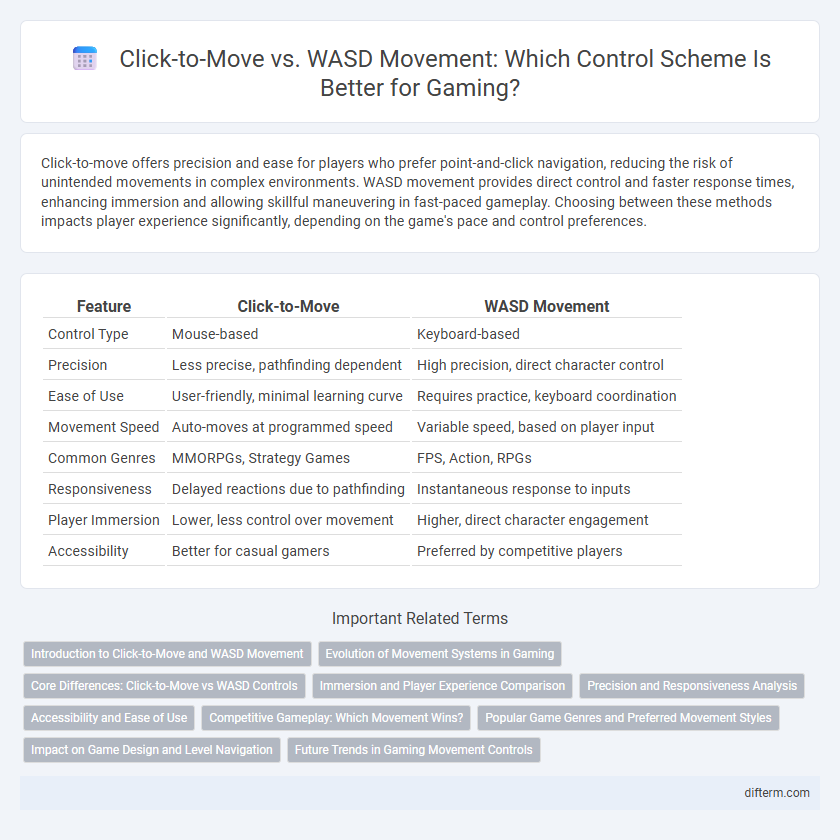Click-to-move offers precision and ease for players who prefer point-and-click navigation, reducing the risk of unintended movements in complex environments. WASD movement provides direct control and faster response times, enhancing immersion and allowing skillful maneuvering in fast-paced gameplay. Choosing between these methods impacts player experience significantly, depending on the game's pace and control preferences.
Table of Comparison
| Feature | Click-to-Move | WASD Movement |
|---|---|---|
| Control Type | Mouse-based | Keyboard-based |
| Precision | Less precise, pathfinding dependent | High precision, direct character control |
| Ease of Use | User-friendly, minimal learning curve | Requires practice, keyboard coordination |
| Movement Speed | Auto-moves at programmed speed | Variable speed, based on player input |
| Common Genres | MMORPGs, Strategy Games | FPS, Action, RPGs |
| Responsiveness | Delayed reactions due to pathfinding | Instantaneous response to inputs |
| Player Immersion | Lower, less control over movement | Higher, direct character engagement |
| Accessibility | Better for casual gamers | Preferred by competitive players |
Introduction to Click-to-Move and WASD Movement
Click-to-move and WASD movement represent two fundamental control schemes in gaming, catering to different playstyles and genres. Click-to-move allows players to navigate characters by clicking on the desired destination, often seen in strategy and role-playing games for precise positioning. WASD movement offers direct keyboard control, enabling real-time, fluid character movement preferred in action, shooter, and adventure games.
Evolution of Movement Systems in Gaming
Click-to-move and WASD movement systems represent key milestones in the evolution of gaming controls, reflecting shifts in player interaction and game design. Click-to-move, popularized by early MMORPGs and strategy games, emphasizes point-and-click precision for character navigation, while WASD offers real-time, tactile control favored in first-person and action titles. Developers increasingly integrate hybrid models to balance accessibility with immersion, showcasing the ongoing refinement of movement mechanics tailored to diverse gameplay experiences.
Core Differences: Click-to-Move vs WASD Controls
Click-to-move controls allow players to navigate characters by clicking on specific points in the game environment, offering precision and ease for strategic positioning. WASD movement provides real-time, tactile control through keyboard input, enabling dynamic and responsive character movement suited for fast-paced gameplay. Each method influences player interaction and game pacing, with click-to-move favoring deliberate actions and WASD emphasizing continuous control and agility.
Immersion and Player Experience Comparison
Click-to-move controls in gaming often enhance immersion by allowing players to focus on strategic positioning and environmental awareness without managing manual navigation, creating a seamless and intuitive experience. WASD movement, while offering precise control and dynamic interaction, can increase player engagement through direct character maneuvering but may demand higher cognitive load, potentially impacting long-term immersion. Player experience varies; click-to-move suits casual and accessibility-focused gameplay, whereas WASD appeals to players seeking skill-based, real-time movement immersion.
Precision and Responsiveness Analysis
Click-to-move movement offers high precision by allowing players to select exact destinations with minimal input, which is particularly advantageous in strategy and point-and-click games. WASD movement provides superior responsiveness and real-time control, enabling players to dynamically adjust their positioning in fast-paced environments and action titles. The choice between these control schemes often depends on the desired balance between precise navigation and immediate, fluid responsiveness in gameplay.
Accessibility and Ease of Use
Click-to-move controls offer enhanced accessibility by reducing the need for precise keyboard input, making it easier for players with limited dexterity or mobility impairments to navigate game environments. WASD movement provides granular control and faster responsiveness, favored by experienced gamers seeking precise maneuvers but can be challenging for beginners or those with hand coordination difficulties. Games that integrate customizable control schemes combining click-to-move and WASD movement maximize ease of use and inclusivity for diverse player abilities.
Competitive Gameplay: Which Movement Wins?
In competitive gameplay, click-to-move offers precision and reduced physical strain, allowing players to execute complex maneuvers effortlessly, while WASD movement provides greater real-time control and responsiveness essential for twitch-based actions. Esports titles like League of Legends favor click-to-move for strategic positioning, whereas first-person shooters such as Counter-Strike rely heavily on WASD for rapid directional input and aiming accuracy. Ultimately, the optimal movement method depends on the genre and required skillset, with each offering unique advantages for competitive success.
Popular Game Genres and Preferred Movement Styles
Popular game genres such as MMORPGs and strategy games often favor click-to-move mechanics for precise positioning and ease of navigation. In contrast, fast-paced genres like FPS and action RPGs typically adopt WASD movement to provide players with direct and responsive control. Player preference in movement styles is influenced by gameplay intensity, with tactical games leaning towards click-to-move while reflex-driven titles emphasize WASD.
Impact on Game Design and Level Navigation
Click-to-move mechanics enable point-and-click navigation that simplifies user input, allowing for more strategic level design with clearly defined paths and interactive elements. WASD movement offers direct control and precision, fostering open-world exploration and dynamic obstacle navigation, which enhances player immersion and responsiveness. Game designers must balance these movement systems to optimize player engagement and ensure intuitive level flow tailored to gameplay style.
Future Trends in Gaming Movement Controls
Future trends in gaming movement controls emphasize hybrid systems combining click-to-move accuracy with the fluidity of WASD inputs, enhancing player experience in both RPGs and action games. Advances in AI-driven adaptive controls and haptic feedback are expected to create more immersive and intuitive navigation, blending traditional keyboard inputs with gesture and eye-tracking technology. Developers are increasingly prioritizing customizable control schemes to accommodate diverse player preferences and accessibility needs, shaping the evolution of movement mechanics in next-gen gaming.
click-to-move vs WASD movement Infographic

 difterm.com
difterm.com